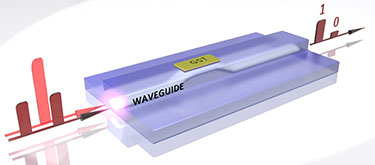
The novel all-optical, on-chip data memory device stores information by changing the phase state of GST from crystalline to amorphous and back, enabling fast read/writing. Credit: C. Rios / Oxford University
Fiber-optic long-haul networks have for many years carried our communications across the globe, but photons reach a bottleneck at the storage level, where they must be converted to slower electronic signals for processing and storage. Practical optical storage on a chip is a solution to this speed limit in conventional computers, but has remained elusive because it’s difficult to integrate optical memory with electronic processing, and to store photons for long periods of time. In what could be a breakthrough development, a team of German and U.K. researchers have discovered a way to store photons using non-volatile phase-change materials (Nat. Phot., doi:10.1038/nphoton.2015.182).
A group at the Universities of Oxford, Exeter and Muenster and the Karlsruhe Institute of Technology chose to work with the well-understood phase-change alloy Ge2Sb2Te5 (GST), which has data retention capabilities and high state discrimination at the nanometer-scale. In the prototype device, a cell of GST sits on top of a nanophotonic waveguide, where ultrashort optical pulses of light initiate a phase change in the material to perform reading and writing of a signal at potential frequencies of up to a gigahertz. Readout of data exiting the waveguide occurs via low-power optical pulses at faster speeds using less energy than conventional electrical memories.
Furthermore, the on-chip photonic memory device can multiplex three bits into and out of the waveguide for fast, random access into and out of an architecture with eight levels of storage in a single cell.
Harish Bhaskaran, professor of materials at the University of Oxford, says, “The memory is compatible not only with conventional optical fiber data transmission, but also with the latest processors,” which could mean incorporation of all-optical storage is conceivable in the near future.
